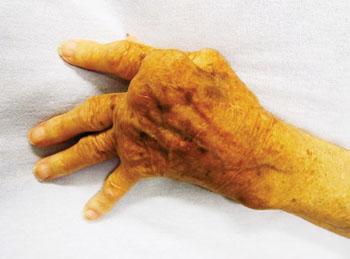Blood Test Aids Early Detection of Rheumatoid Arthritis
|
By LabMedica International staff writers Posted on 09 Mar 2015 |

Image: Severe rheumatoid arthritis in a hand which was never treated (Photo courtesy of James Heilman, MD).
A blood test that measures the levels of a certain protein can be used in conjunction with clinical assessments to assist with the diagnosis of rheumatoid arthritis is now available in North America.
Rheumatoid arthritis (RA) is a chronic, systemic inflammatory disorder that primarily affects joints and it may result in deformed and painful joints, which can lead to loss of function. The disease may also have signs and symptoms in organs other than joints.
The JOINTstat test (Augurex Life Science; Vancouver, BC, Canada) measures 14-3-3η (eta), a protein involved in joint damage that leads to debilitation in patients with RA, a disease that affects one out of every 100 Canadians. High levels of 14-3-3η protein indicate that the patient should be referred to a rheumatologist. JOINTstat has been evaluated in clinical studies in over 3,000 patients and has been available in the USA since late 2013.
Extracellular 14-3-3η protein is a potent ligand and activator of intracellular signaling pathways that lead to the upregulation of inflammation and joint damage factors involved in RA pathogenesis. A quantitative enzyme-linked immunosorbent assay is used to assess 14-3-3η protein levels. Studies have shown that when the test is positive, greater than 0.19 ng/mL, it provides a 5 to 50 times greater likelihood of having RA versus non-RA. At high levels of greater than 80 ng/mL is an indicator of RA that will lead to more joint damage over three years and at lower levels of less than 0.4 ng/mL or negative in RA diagnosed patients indicates a higher likelihood of response to RA therapy.
Walter Maksymowych, MD, FRCPC, a professor in the department of medicine, division of rheumatology at the University of Alberta (Edmonton, AB, Canada) said, “When diagnosed early, rheumatoid arthritis can be better managed with drug therapies, resulting in better outcomes by limiting disease progression. Current diagnostic tests are limited in their ability to catch the disease early. With the availability of JOINTstat in Canada, physicians now have the opportunity to treat rheumatoid arthritis early, prior to the onset of significant joint damage. This represents an important milestone towards the goal of personalized medicine.” The study was presented at the Canadian Rheumatology Association (CRA) Annual Scientific Meeting held February 4–7, 2015, in Québec City (QC, Canada).
Related Links:
Augurex Life Science
University of Alberta
Rheumatoid arthritis (RA) is a chronic, systemic inflammatory disorder that primarily affects joints and it may result in deformed and painful joints, which can lead to loss of function. The disease may also have signs and symptoms in organs other than joints.
The JOINTstat test (Augurex Life Science; Vancouver, BC, Canada) measures 14-3-3η (eta), a protein involved in joint damage that leads to debilitation in patients with RA, a disease that affects one out of every 100 Canadians. High levels of 14-3-3η protein indicate that the patient should be referred to a rheumatologist. JOINTstat has been evaluated in clinical studies in over 3,000 patients and has been available in the USA since late 2013.
Extracellular 14-3-3η protein is a potent ligand and activator of intracellular signaling pathways that lead to the upregulation of inflammation and joint damage factors involved in RA pathogenesis. A quantitative enzyme-linked immunosorbent assay is used to assess 14-3-3η protein levels. Studies have shown that when the test is positive, greater than 0.19 ng/mL, it provides a 5 to 50 times greater likelihood of having RA versus non-RA. At high levels of greater than 80 ng/mL is an indicator of RA that will lead to more joint damage over three years and at lower levels of less than 0.4 ng/mL or negative in RA diagnosed patients indicates a higher likelihood of response to RA therapy.
Walter Maksymowych, MD, FRCPC, a professor in the department of medicine, division of rheumatology at the University of Alberta (Edmonton, AB, Canada) said, “When diagnosed early, rheumatoid arthritis can be better managed with drug therapies, resulting in better outcomes by limiting disease progression. Current diagnostic tests are limited in their ability to catch the disease early. With the availability of JOINTstat in Canada, physicians now have the opportunity to treat rheumatoid arthritis early, prior to the onset of significant joint damage. This represents an important milestone towards the goal of personalized medicine.” The study was presented at the Canadian Rheumatology Association (CRA) Annual Scientific Meeting held February 4–7, 2015, in Québec City (QC, Canada).
Related Links:
Augurex Life Science
University of Alberta
Latest Immunology News
- Blood Test Could Identify Colon Cancer Patients to Benefit from NSAIDs
- Blood Test Could Detect Adverse Immunotherapy Effects
- Routine Blood Test Can Predict Who Benefits Most from CAR T-Cell Therapy
- New Test Distinguishes Vaccine-Induced False Positives from Active HIV Infection
- Gene Signature Test Predicts Response to Key Breast Cancer Treatment
- Chip Captures Cancer Cells from Blood to Help Select Right Breast Cancer Treatment
- Blood-Based Liquid Biopsy Model Analyzes Immunotherapy Effectiveness
- Signature Genes Predict T-Cell Expansion in Cancer Immunotherapy
- Molecular Microscope Diagnostic System Assesses Lung Transplant Rejection
- Blood Test Tracks Treatment Resistance in High-Grade Serous Ovarian Cancer
- Luminescent Probe Measures Immune Cell Activity in Real Time
- Blood-Based Immune Cell Signatures Could Guide Treatment Decisions for Critically Ill Patients
- Novel Tool Predicts Most Effective Multiple Sclerosis Medication for Patients
- Companion Diagnostic Test for CRC Patients Identifies Eligible Treatment Population
- Novel Tool Uses Deep Learning for Precision Cancer Therapy
- Companion Diagnostic Test Identifies HER2-Ultralow Breast Cancer and Biliary Tract Cancer Patients
Channels
Clinical Chemistry
view channel
Noninvasive Blood-Glucose Monitoring to Replace Finger Pricks for Diabetics
People with diabetes often need to measure their blood glucose multiple times a day, most commonly through finger-prick blood tests or implanted sensors. These methods can be painful, inconvenient, and... Read more
POC Breath Diagnostic System to Detect Pneumonia-Causing Pathogens
Pseudomonas aeruginosa is a major cause of hospital-acquired and ventilator-associated pneumonia, particularly in lung transplant recipients and patients with structural lung disease. Its ability to form... Read moreMolecular Diagnostics
view channel
World's First NGS-Based Diagnostic Platform Fully Automates Sample-To-Result Process Within Single Device
Rapid point-of-need diagnostics are of critical need, especially in the areas of infectious disease and cancer testing and monitoring. Now, a direct-from-specimen platform that performs genomic analysis... Read more
Rapid Diagnostic Breakthrough Simultaneously Detects Resistance and Virulence in Klebsiella Pneumoniae
Antibiotic resistance is a steadily escalating threat to global healthcare, making common infections harder to treat and increasing the risk of severe complications. One of the most concerning pathogens... Read moreHematology
view channel
MRD Tests Could Predict Survival in Leukemia Patients
Acute myeloid leukemia is an aggressive blood cancer that disrupts normal blood cell production and often relapses even after intensive treatment. Clinicians currently lack early, reliable markers to predict... Read more
Platelet Activity Blood Test in Middle Age Could Identify Early Alzheimer’s Risk
Early detection of Alzheimer’s disease remains one of the biggest unmet needs in neurology, particularly because the biological changes underlying the disorder begin decades before memory symptoms appear.... Read more
Microvesicles Measurement Could Detect Vascular Injury in Sickle Cell Disease Patients
Assessing disease severity in sickle cell disease (SCD) remains challenging, especially when trying to predict hemolysis, vascular injury, and risk of complications such as vaso-occlusive crises.... Read more
ADLM’s New Coagulation Testing Guidance to Improve Care for Patients on Blood Thinners
Direct oral anticoagulants (DOACs) are one of the most common types of blood thinners. Patients take them to prevent a host of complications that could arise from blood clotting, including stroke, deep... Read moreMicrobiology
view channel
New UTI Diagnosis Method Delivers Antibiotic Resistance Results 24 Hours Earlier
Urinary tract infections affect around 152 million people every year, making them one of the most common bacterial infections worldwide. In routine medical practice, diagnosis often relies on rapid urine... Read more
Breakthroughs in Microbial Analysis to Enhance Disease Prediction
Microorganisms shape human health, ecosystems, and the planet’s climate, yet identifying them and understanding how they are related remains a major scientific challenge. Even with modern DNA sequencing,... Read morePathology
view channel
AI Tool Simultaneously Identifies Genetic Mutations and Disease Type
Interpreting genetic test results remains a major challenge in modern medicine, particularly for rare and complex diseases. While existing tools can indicate whether a genetic mutation is harmful, they... Read more
Rapid Low-Cost Tests Can Prevent Child Deaths from Contaminated Medicinal Syrups
Medicinal syrups contaminated with toxic chemicals have caused the deaths of hundreds of children worldwide, exposing a critical gap in how these products are tested before reaching patients.... Read more
Tumor Signals in Saliva and Blood Enable Non-Invasive Monitoring of Head and Neck Cancer
Head and neck cancers are among the most aggressive malignancies worldwide, with nearly 900,000 new cases diagnosed each year. Monitoring these cancers for recurrence or relapse typically relies on tissue... Read moreTechnology
view channel
Diagnostic Chip Monitors Chemotherapy Effectiveness for Brain Cancer
Glioblastoma is one of the most aggressive and fatal brain cancers, with most patients surviving less than two years after diagnosis. Treatment is particularly challenging because the tumor infiltrates... Read more
Machine Learning Models Diagnose ALS Earlier Through Blood Biomarkers
Amyotrophic lateral sclerosis (ALS) is a rapidly progressive neurodegenerative disease that is notoriously difficult to diagnose in its early stages. Early symptoms often overlap with other neurological... Read moreIndustry
view channel
BD and Penn Institute Collaborate to Advance Immunotherapy through Flow Cytometry
BD (Becton, Dickinson and Company, Franklin Lakes, NJ, USA) has entered into a strategic collaboration with the Institute for Immunology and Immune Health (I3H, Philadelphia, PA, USA) at the University... Read more






















